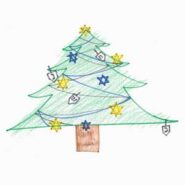Mixed-Up Traditions

If you had any rough moments with your children over the holidays, remember that you can still go back, SAY WHAT YOU SEE and reconnect with a do-over. Here’s one about mixed-up traditions:
During the holiday season, I was overseeing free art time in a 5-year-old classroom. One little girl, Leah, came from a Jewish family that celebrated Hanukkah. However, most of her classmates celebrated Christmas, so there was a fair amount of discussion and excitement in the classroom regarding the upcoming holiday.
When Leah’s mom arrived to pick her up, she asked Leah what she was working on. Leah proudly showed her mom the drawing she had made, and explained that it was a “Hanukkah Tree.” She had drawn a fir tree, but instead of ornaments and candy canes, it was decorated blue and yellow and covered with Stars of David and dreidels.
Her mom expressed disapproval and reminded Leah that they celebrated Hanukkah, not Christmas. When Leah interjected, “I know Mom, it’s a Hannukah Tree!” her mom explained that there was no such thing; Hanukkah did not include a tree of any sort. When she was done explaining, Leah had a look of resignation and her mom looked upset.
Rather than feeling pride and excitement about her own traditions, Leah felt like she had done something wrong. I know this is not what her mother wanted for her. If Leah’s mom had responded with Say What You See instead of disapproval right then, things could have turned out differently for both of them. And, because children always welcome do-overs, an acknowledgment would still be valuable today:
SWYS: Remember when you drew a Hanukkah tree at school, and I didn’t understand?
Child: Yeah, it was just a tree with Hanukkah decorations.
SWYS: I realized later that you probably wanted to draw a Christmas tree like the other kids, but knew that we celebrate Hanukkah instead, so you found a way to put the two together. That tells me that you know the two traditions are different, and you know which ones are ours!
When you do a do-over, get ready for a hug, because when children feel understood and their intentions are acknowledged, the communication is complete and connection is restored.
Sometimes, however, a child has more to communicate. For example, if the conversation above revealed that the tree drawing was part of a secret wish to celebrate Christmas, the mom could continue to maintain her boundary of celebrating Hanukkah in a traditional manner and validate her daughter’s wishes, too, by granting wishes in fantasy:
Child: I know our traditions are different, but it would be fun to have Christmas at our house, too.
CAN DO (wishes): Sounds like you wish you could decorate your own Hanukkah tree for real, just like in your drawing!
Child: Yeah, and then we could make a Christmas menorah, and gingerbread dreidels, and there would be double presents!
SWYS: Wow! You can think of lots of fun and creative combinations. And of course, double presents! I’m guessing that would be your favorite part!
Boundary/CAN DO: And we only celebrate Hanukkah. Hmmm. Must be some other way you can make it double fun next year…
Often when a child’s wishes have been heard and validated, the child simply moves on. If not, you can add a boundary and CAN DO as above, if you think they’re still needed. Either way, with acknowledgment and wish-granting (in do-overs or in the moment), you can create a safe space for expression that diffuses power struggles and allows children to accept your boundaries — including embracing your family’s holiday traditions — on their own.
What rough moments with your kids could be reversed by a do-over now?





